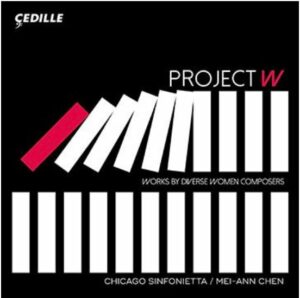We’ve followed the important work of the Chicago Sinfonietta for many years (for instance, here is our 2013 interview with their music director, Mei Ann Chen) and are happy to present a review of their latest CD, reviewed by Quinn Mason. Quinn’s previous post for us was “On Diversity in Music.”
Cedille Records has recently released Project W, a showcase of music composed by diverse women composers and performed by the Chicago Sinfonietta and their music director, Mei-Ann Chen. All of the compositions (except the Florence Price) on the CD are commissions from Chicago Sinfonietta and all were performed in concert prior to their recording. Represented are five women of different races and backgrounds, all of them primarily working in the United States.
The album starts off with the world premiere recording of Dances in the Canebrakes, composed by Florence Price (1887-1953) and arranged for orchestra by her contemporary, the eminent composer William Grant Still (1895-1978). Florence Price is a very interesting historical figure, as the first significant African American female composer in history. Her Chicago roots are appropriate for the album, as she lived most of her life in that city and had her Symphony No. 1 in E Minor performed by the Chicago Symphony Orchestra and Frederick Stock in 1933.
Dances in the Canebrakes was originally composed for piano in 1953, the last year of her life. This composition consists of three short movements. The first movement, Nimble Feet, is surprisingly lushly orchestrated for the title, but still has a sense of elevated lightness. Tropical Noon features an infectious Latin-like rhythm and exotic percussion (which fits its title perfectly). The last movement, Silk Hat and Walking Cane, is a grand, elegant and fitting conclusion to this small suite of dances.
The next selection is by Clarice Assad (b. 1978), a Brazilian-American vocalist, composer, arranger and pianist whose compositions are inspired by Jazz, global music and Brazilian culture. Sin Fronteras is a melding of just that; one will notice the jazz harmonies and the rhythms that give a distinct exotic feel with contemporary elements. The orchestration is brilliant and makes use of all sections of the orchestra in a virtuosic manner.
Jessie Montgomery (b. 1981), a rising star in the classical music world, is making a name for herself with dynamic and interesting compositions, the most popular of which is the string orchestra piece, Starburst. The work on this album, Coincident Dances, is a blend of different styles including sounds from Africa, England, Brazil and even from American dance clubs. Montgomery seamlessly fuses these sounds into a zestful and lively composition, complete with fantastic solos and section features. At around 11 minutes, it is short and to the point, but every minute is filled with enjoyable and memorable musical moments.
Reena Esmail (b. 1983) is the youngest composer represented on the album, with two selections, ‘Charukeshi Bandish, a piece inspired by traditional Hindu music and #metoo after the recent movement for sexual assault victims and based on the composer’s own experiences. Charukeshi Bandish featuring a haunting vocal line sung by the composer herself, and #metoo utilizes a theme which navigates its way through everchanging orchestration, struggling to find itself along the way. Both pieces are impressively written and aptly demonstrate the composer’s considerable gift for storytelling.
The last selection on the album is by Jennifer Higdon (b. 1962), who teaches at the Curtis Institute of Music. Dr. Higdon is one of the most programmed and performed contemporary composers in the world. One listen to the work on this album, Dance Card, and it’s easy to see (and hear) why. This five-movement work for string orchestra consists of three short dances and two reflective sections. The dances (movements 1, 3 and 5) are short and punchy which grab and keep the listeners attention throughout. Higdon’s characteristic and creative use of rhythm is the real highlight of these short pieces. The more expansive movements (2 and 4), feature lush chords and rich solos for the violin and cello. The 4th movement in particular, called Celestial Blue, conjures up memories of her widely performed orchestral piece blue cathedral.
This is a solid and engaging album for those who would like those would like to discover interesting music that has been written by talented women composers (mostly) living and working today and even (in the case of Florence Price) shining light on a unique voice that had been previously neglected.
